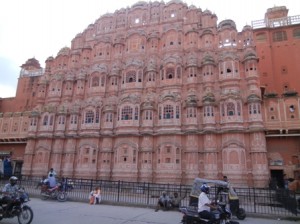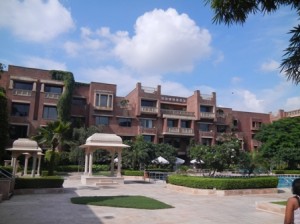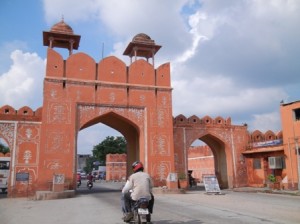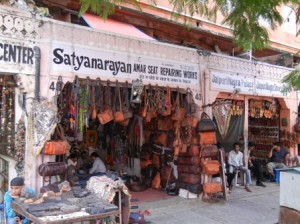Driving around Jaipur, you aptly wonder why it is called the ‘Pink City’ – for it is anything but pink. It is a fiery to a sunburnt orange in some places, brick red in some while all the upcoming quarters are Gurgaon-gray. But the ‘pink’ goes way back and we are not prepared to let go of it for reasons not really connected to history or heritage. Way back in 1876 when Edward, Prince of Wales came visiting Maharajah Ram Singh ordered the city to be painted wholly and completely in pink. Now, what would possess anybody to paint a city pink?
Athithi Devo Bhava. One vague guess would be the visiting dignitary’s legendary tastes being indulged by the host’s legendary hospitality. King Edward was dandy and a not-so-discreet Don Juan who had at least 55 paramours. He was impartial in his choices when it came to taking lovers – they included actresses, singers, and wives of British parliamentarians to hookers. One of them also included Alice Keppel whose great granddaughter Camilla Parker Bowles later became the mistress and wife of the current Price of Wales, Charles. His pretty wife Alexandra, though in the know of his romps, instead of raising a ruckus, chose to be busy entertaining socialites lavishly at their Marlborough House residence and putting up with a nagging, interfering mother-in-law the Queen Victoria. King Edward struck the right kind of notes with everybody more so for his liberal views than for his colourful life, slamming prejudices of every sort. He was the first one to decry the use of ‘nigger’ as disgraceful. ‘Because a man has a black face and a different religion from our own, there is no reason why he should be treated as a brute,’ he wrote after his visit to India. The visit was so successful that it earned his mother the title of ‘Empress of India’. It also made Jaipur pink.The moniker notwithstanding, Jaipur otherwise is a remarkable city. It is outstanding for its planning among the pre-modern cities of India. But too much planning and the resultant symmetry can make you go around in circles, at least on the first day of your visit. But once you get the hang of it, you can find your way around drunk or blindfolded. The modern, well-laid out city of Chandigarh is testimony to this (I been around here drunk). On my way to lunch, I passed the Hawa Mahal twice. The second time I thought of stopping to check whether it really resembled the throne of Krishna. But actually I was trying to think of things other than my hunger gnawing vents in my entrails. Looming over me to its reported 50 feet, this five-story mahal or palace was from where the royal ladies watched processions without being seen. The ornate latticework on the windows also made it resemble a beehive which served to further screen the womenfolk from public scrutiny. The large number of windows – 953 of them – also saw to it that the place was well-breezed making it comfortable during the extreme desert summers.
As soon as I tilted my head upwards, I was accosted by a youngster who first grinned at me through paan-stained teeth. I grinned back through my broken ones. An air of mateyness surrounded us till he offered to show me around for ‘only one hunner rupees’. I normally try to accommodate the locals however hungry but just then a wind blew which made me realise why I was the only tourist in sight: up wafted all nose-cringing kind of stinks from the place which made me want to run which I did.“Sir, I show you famous Hawa Mahal…” I heard the paan-stain behind me as I ran.
“I have seen it,” I told him. “And I now I know how it smells too.”
The ITC Rajputana was brick red, not pink. It rose like the Bedouin lord decided to settle in that part of the desert because of the shady oases with its inviting blue pool. It looked more like a luxurious auberge – the only ones missing were the burnouse-clad men with their dromedaries. The spotless piste marked its way around well-trimmed lawns and soft tussocks wrapped the trunks of the adorning palm trees in a curlicue. Marble marquees stood like miniature apadana models from where the sagacious patriarch would admire his exemplary work, sipping from his pokal, reflecting on his numerous war victories or thinking fondly about his favourite wife. Probably plan his next conquest. It was late afternoon and a lovat sky painted a comfortable contrast against the stately low rises. I still hadn’t had my lunch.
As I waited for my non-vegetarian Rajasthan thali, I culled out some wonderful insights into the state’s diet and habits from the nicely written introduction on the placard menu. In this drought prone region where the inhabitants were usually at war with neighbouring kingdoms the preferred food was something which would last for several days and which could be eaten without being heated. Scarcity of water, especially in the regions of Barmer, Jaisalmer and Bikaner, gave rise to increased use of milk, buttermilk and clarified butter for cooking. There were endless variations for the papad which would be dried to be kept in storage to be later turned into curries. The epiphany to the indigenously developed styles of cooking and recipes – definitely a tribute to the indomitable spirit of the inhabitants – ended with the sprightly ‘There is a saying in Rajasthan that you don’t relish your food until you sweat while eating’. I had skipped the starters for obvious reasons and had gone straight to the Jeeman instead – the main course. The thali served in authentic silverware comprised of some real ethnic stuff from Rajasthan maintained with understandable pride by the hotel owners. The gatta ki sabzi was a local delicacy made with gram flour, there was a khichdi made from bajra and mangodi which was basically powdered lentils. And of course there was the lal maans or mutton curry which made me sweat. Heading out, I passed through an ancient gateway which was a distinct orange, not pink. And for the third time that day, I passed again in front of the Hawa Mahal. This time I stopped a little ahead of the monument to escape the winds. This ‘specimen of fanciful architecture’ is right at the main road intersection and is lined by small shops on both sides of the street. These shops sell everything from colourful bangles to leather bags, paints to plywood, Rs 25,000 tour packages to Kashmir to Photostat at 60 paisa per copy. They were all housed in single story heritage buildings, nature of business announced in bold black letters on concrete-white background. I was told that preservation laws mandated that no signage be nailed or hung from the buildings. Talking about restoration, the Hawa Mahal itself was given some restoration and renovation touches in 2005 – after a gap of half a century. Financial behemoth Unit Trust of India has adopted the monument for maintenance and so far Rs 45 lakh (almost half a million Indian rupees) has gone in the noble effort. This strangely hasn’t included constructing enough public urinals in the area so that the historic monument is spared of the bladder-wrath. The shopkeepers all engage you in hearty conversation when they find that you are from Delhi – the bulk of their customers are from Delhi – till a westerner walks in, fanning crab-red (not pink) faces vigorously with straw hats. It was just a few days ago that the most furious rains since 30 years had lashed the city killing at least 10. Though parts of the city was underwater and the army had to be called to pump out the water, the chief minister of the state was vehement in his assurances that it was not ‘flood but flood-like situation’. He had been finalising the details of a massive drought package from the central authorities by declaring Jaipur drought-hit. Jal Mahal and Nahargarh Fort were the most affected among the star tourist attractions of the city with walls collapsing in the deluge. I looked up at the Hawa Mahal, untouched by the ravage, really happy to see it rise indestructible against the soft evening light. I stood there smiling at the regal ladies behind the jharokhas, catching the susurration of their muted conversation.And then the wind took it all away.
















